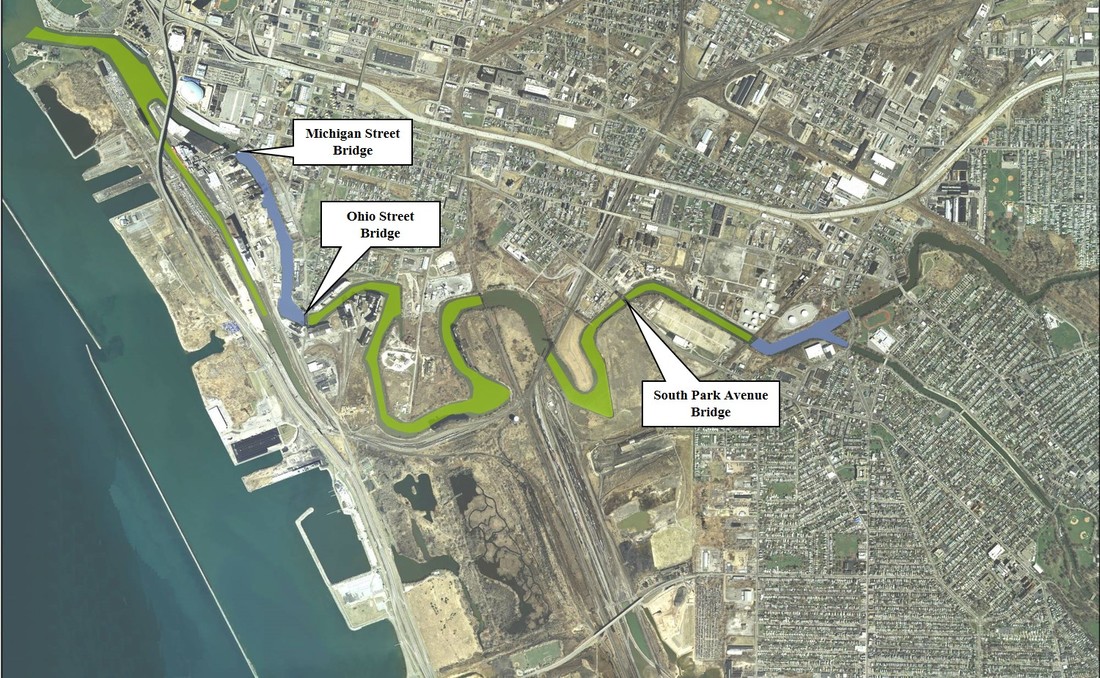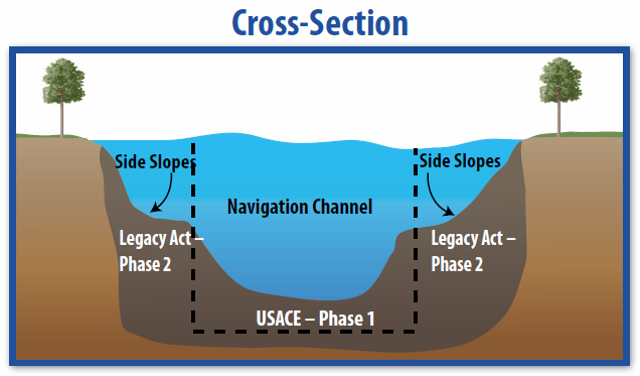The sediment cleanup of the Buffalo River is complete!
The Buffalo River has been cleaned up, ready for recreational use by residents and tourists! About one million cubic yards of contaminated sediment were dredged from the river. To jump start habitat, clean sand, plants, and fish structures were installed on the river's bottom. The transformation has helped the river become a beneficial community resource, both environmentally and economically.
Before cleanup, the river suffered from poor water quality, degraded fish and wildlife habitat, and contaminated sediment. The Buffalo River Restoration Partnership formed in response in a unique public-private collaboration: U. S. Environmental Protection Agency, U. S. Army Corps of Engineers, New York State Department of Environmental Conservation, Buffalo Niagara Riverkeeper® and Honeywell. Visit the New York DEC website for more information.
Before cleanup, the river suffered from poor water quality, degraded fish and wildlife habitat, and contaminated sediment. The Buffalo River Restoration Partnership formed in response in a unique public-private collaboration: U. S. Environmental Protection Agency, U. S. Army Corps of Engineers, New York State Department of Environmental Conservation, Buffalo Niagara Riverkeeper® and Honeywell. Visit the New York DEC website for more information.
Location
The cleanup fell within the lower six miles of the Buffalo River and the City Ship Canal. Areas in green and blue show the extent of the Buffalo River AOC with dredging and capping taking place in these highlighted areas.
Cleanup Process
|
The cleanup occurred in two phases. In Phase 1, the Army Corps dredged out the backlog of contaminated sediment in the federal navigation channel to authorized navigation depth, meeting the objectives of a cleaner and more navigable river. Phase 2 was performed under the Great Lakes Legacy Act and targeted side slopes of the river and sediment below the authorized depth in the navigation channel.
|
Phase 1
Sediment remediated: 550,000 cubic yards Contaminants: PCBs, PAHs, lead, and mercury Method: Mechanical dredging When: 2011 and 2012 Partners: U.S. Army Corps of Engineers, U.S. Environmental Protection Agency Cost: $4.5 Million Great Lakes Restoration Initiative funding plus base Army Corps funding Note: U. S. Army Corps Strategic Navigation Dredging project Phase 2
Sediment remediated: 495,000 cubic yards Contaminants: PCBs, PAHs, lead, and mercury Method: Mechanical dredging When: 2013 - 2014 Partners: U.S. Environmental Protection Agency, New York State Department of Environmental Conservation, Honeywell, Buffalo Niagara Riverkeeper® Cost: $43 Million Note: Great Lakes Legacy Act project |
Long-term Benefits
|
|
View from below
Scuba divers plant wild celery, one of the best aquatic habitats for waterfowl, in the Buffalo River. Credit: Seaway Diving & Salvage
More Information
Documents and Resources
Great Lakes Areas of Concern: Six Strategies to Support Community Revitalization (PDF, 8p, 987KB) 2024
Buffalo’s Revitalization: The Buffalo River Area of Concern (video, 4:24), 2022
Buffalo River brochure (PDF, 2p, 2.72 MB) September 2014
EPA public meeting presentation at Old First Ward Community Center (PDF, 31p, 5.52 MB) September 2013
Buffalo River Restoration Partnership fact sheet (PDF, 2p, 293 KB) August 2011
Buffalo River Restoration Partnership fact sheet (PDF, 3p, 490 KB) December 2010
Buffalo River Restoration Partnership fact sheet (PDF, 4p, 232 KB) May 2010
Buffalo River Restoration Partnership fact sheet (PDF, 2p, 213 KB) September 2009
Great Lakes Areas of Concern: Six Strategies to Support Community Revitalization (PDF, 8p, 987KB) 2024
Buffalo’s Revitalization: The Buffalo River Area of Concern (video, 4:24), 2022
Buffalo River brochure (PDF, 2p, 2.72 MB) September 2014
EPA public meeting presentation at Old First Ward Community Center (PDF, 31p, 5.52 MB) September 2013
Buffalo River Restoration Partnership fact sheet (PDF, 2p, 293 KB) August 2011
Buffalo River Restoration Partnership fact sheet (PDF, 3p, 490 KB) December 2010
Buffalo River Restoration Partnership fact sheet (PDF, 4p, 232 KB) May 2010
Buffalo River Restoration Partnership fact sheet (PDF, 2p, 213 KB) September 2009





